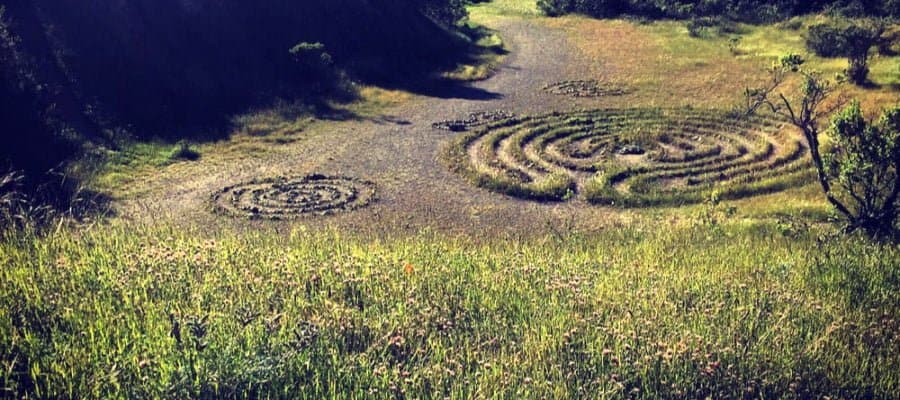Back when I was a grad student at Stanford University, I belonged to a working group of scientists, social scientists, artists, writers, performers, mathematicians, engineers, historians and cultural theorists. We got together and talked about the intersections of our disciplines. We staged “happenings,” put on performances and built things together, kind of like a different style of Burning Man.
A couple of physicists in the group investigated unexplained phenomena that seemed to imply the entanglement of consciousness with objects and the laws of nature. For instance, they investigated changes in the laws of probability due to human attention and intention.
I was admiring, fascinated and also felt sorry for these scientists. While they were measuring how many times a mechanized coin toss landed heads or tails when a nearby person thought of the coin landing heads or tails, I was directly discovering my entanglement with a pervasive, existential consciousness through the practices I was doing on my meditation cushion and beyond.
Pretty much every week or so, someone sends me an article, or writes one, or in some way brings to my attention either a validation of spiritual practice by science, or a debunking of spiritual practice by science. Usually it’s the former.
Let me just say, right now, that it is yogis who can best explain science, not science that can best explain yoga.
Seemingly since I became self-aware (I mean in the ordinary sense), I also became aware that reality was much more than what I was seeing and experiencing.
With that insight came enormous frustration. I spent my childhood and young adulthood feeling that I was banging my brain and all of my other senses against a wall. Behind that wall was it. “It” meant what was really going on here, and who I really was.
Because of my longing for it, or what my Satguru Anandamayi Ma called “that,” I loved the imaginative literature of science fiction, and then later on, I fell in love with science.
In my undergrad years, I took a large number of science courses: from physiology, biology and genetics to biothermodynamics, organic chemistry, cytology, physics, astronomy and even exobiology – the study of what conditions might give rise to life on other planets. On my summer vacations, I worked in a microbiology lab. I also studied a lot of philosophy.
In my Ph.D. program, I took a bunch of history of science and technology courses, too. And cultural theory. And I still loved science fiction.
Along the way, I realized that whatever explanations or techniques these disciplines could produce, they would always, by default, be extremely limited. Interesting and useful, but limited.
How did I realize that? By the time I hit grad school, I had been doing practices such as mantra and kriya yoga every day for more than ten years. About three years into my Ph.D. program, I met a new teacher and started doing many more hours of sadhana daily.
My senses opened. My mind opened. My experience become more subtle. The process of understanding reality directly, with my own body, energy and mind, sped up enormously. I realized that I didn’t need science to find “it,” and that in fact, doing spiritual practice was a much more efficient and comprehensive methodology.
I discovered that we live in a subjective reality and that objectivity is just a concept.
Of course, there is an entire subgenre of the yoga and science meme that covers the “theory” of some scientists that consciousness is the missing universal constant. It’s a little bit hard not to think of those scientists as beloved, erstwhile children.
Seriously, I’m happy that other people have their other ways of grappling with reality. However, scientific practice does not offer the same kind of immersion and direct encounter as yogic practice, nor is it generally as transformative of the lived experience of the human beings who practice it.
These days, I see science as a gross form of yoga—with its own beauty and born of the same impulse, but severely hampered by a limited world view and limited practices.
But the yoga/asana one encounters in most yoga studios is also a gross form of the fuller spiritual practice that I and many others have been taught in traditions from Indian Tantra to Vajrayana Buddhism to Chan Buddhism and Dzogchen. The practices of these traditions, if taught correctly, offer one a useable relationship with reality that is wildly more than ordinary relaxation and general health benefits. The profundity of these practices, and the reality they reveal, only gets further obscured when the scientific “explanation” is added into the mix.
Using rationalistic, mechanistic, and/or “objective” science to explain yogic practice, or validate it, or teach it, is like taking over a Chinese restaurant and attempting to make Norwegian food with Chinese ingredients while still insisting it’s Chinese.
The yogic traditions—the traditions of waking up and discovering the nature of reality—have specificity. They actually have views of their own. And without those views, in my opinion, they are no longer yoga. I mean yoga in the larger sense.
If the yoga and science meme helps people feel more comfortable doing some kind of practice, that’s good. If it gets more funding for yoga and wellness programs in hospitals and workplaces, that’s also good.
But I’d like you to know that there is much more available to you than lowering your blood pressure, improving your health, developing better alignment, sculpting your body and feeling a bit more at ease in the world.
The practices of the various traditions in which I have studied were built for waking up, for Self–realization, for going all the way. They are spiritual technologies for discovering and embodying virtues such as compassion and clarity, for realizing the total equality of all phenomena and thereby coming into profound contentment and equanimity, and for living from the base experience of unconditioned awareness and energy. They open the flood gates to a mighty river of creativity and vitality.
And although I am, after nearly 30 years of daily practice, still playing in the shallow end, I can tell you beyond a shadow of a doubt that the spiritual technologies of these traditions do work.
Oh, and by the way, I still love science fiction.
Love,
Shambhavi

